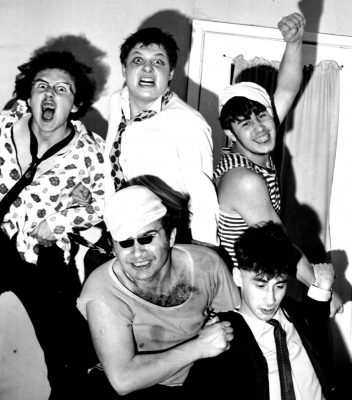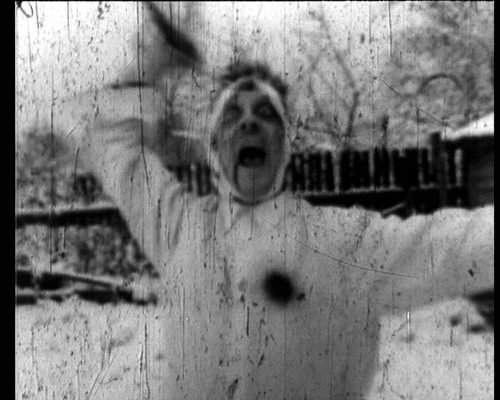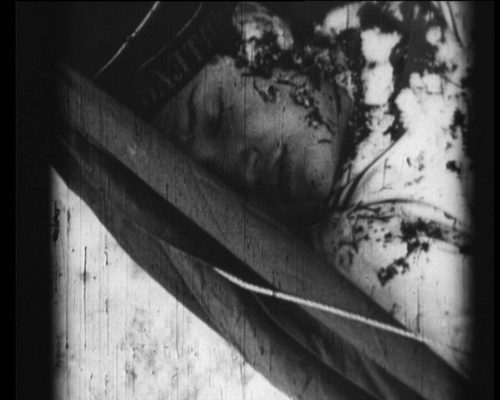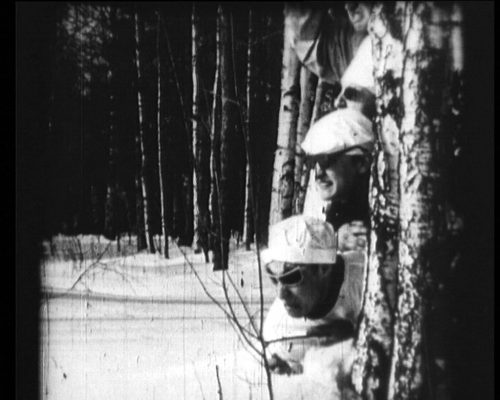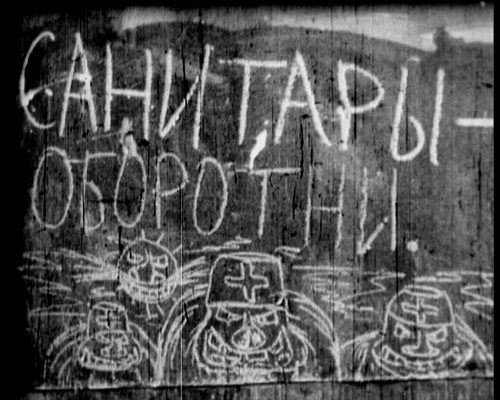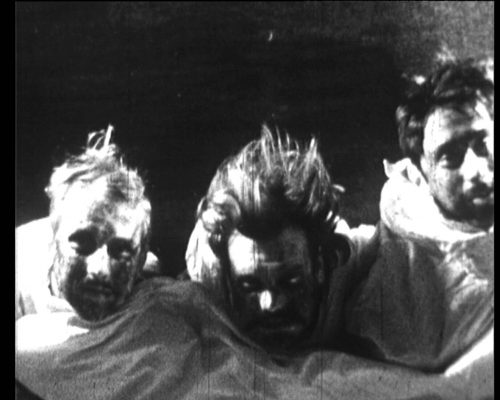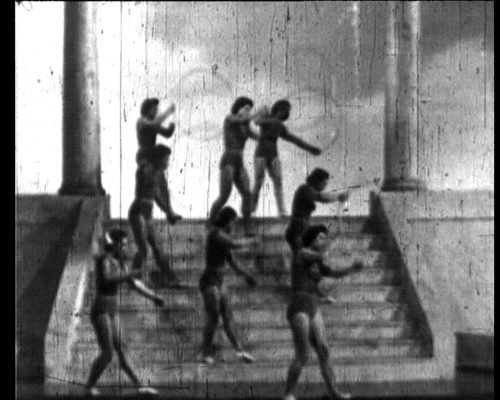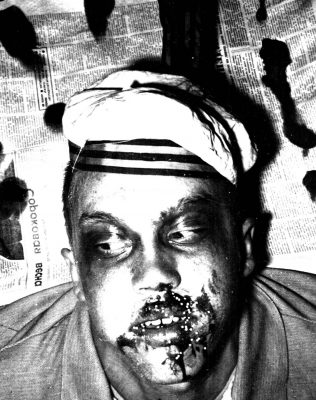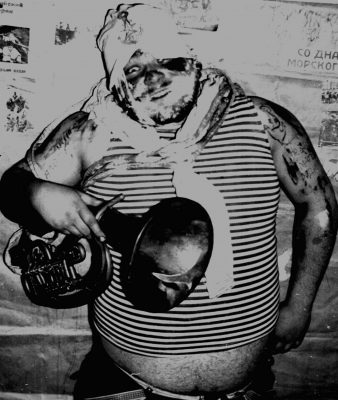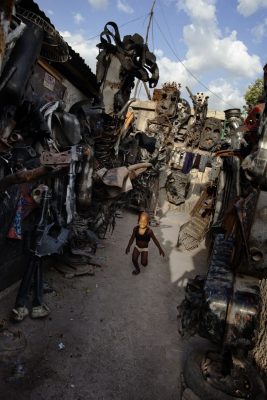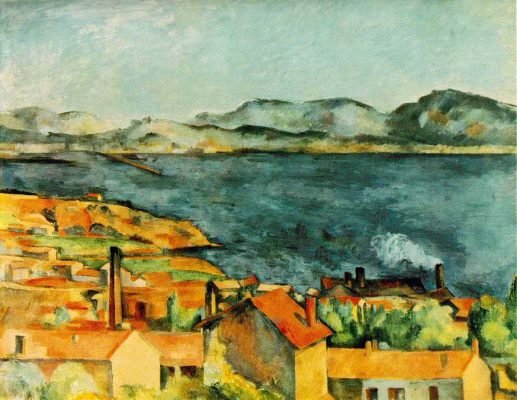Cast as the ‘savage, ugly’ part in the Popular Mechanics live show, Necrorealists were radical artists in their own right, practicing film, painting, photography and performance. They were exclusively young men who appeared to be suffering from a collective breakdown. Their public drunkenness, brawling and unchannelled energies invited chaos. Dressed in medical smocks, army issue long johns and earflap caps (the outfit of the provincial surplus store) Necrorealists differed from ordinary citizens, not in breaking the rules of socialist living, but in following those rules according to their own obtuse interpretations. Under the dismal fog of Leningrad’s northern marsh, this unstable rabble of loiterers, boiler-room attendants, medical orderlies and technical students pursued a grotesque existence which led them first into idiocy and then into a kind of absurd death.
Necrorealism was never a large-scale movement, but it greatly puzzled the Komsomol and other institutions responsible for youth welfare. Necrorealists were dysfunctional and asocial, but they could not be accused of promoting Western lifestyles like the earlier Bitniki and Stilyagi subcultures. Nor did they seem capable of organising conspiratorial activities. Their disinterest in political matters was unwavering, and it was not easy to distinguish a ‘real’ Necro-performance from the general eccentricity spreading amongst the urban populus in the aftermath of Brezhnev’s leadership. Even the Necro ideologue, Evgeny Yufit, admitted that he was engaged in several years of ‘wild and pointless’ activity before realising that it constituted a bona fide worldview.
This formative period of clown-like hooliganism took place in the courtyards and hallways of communal apartments, on suburban trains and in the fetid swamps and forests beyond Leningrad’s industrial sprawl. Here, the Necrorealists would churn up the rotten soil in frenzied battle charges and mass fist fights. The participants at these events were at first barely acquainted with each other, coming together for the sole purpose of expending their pent-up energy.
To the public, these formative Necro-performances must have raised disturbing questions about the young men involved. In a 1989 television broadcast on Leningrad’s The Fifth Wheel, the same programme that would host the Lenin-Mushroom lecture two years later, a team of psychiatrists and a proletarian focus group were shown film clips of the Necrorealists in action. Their stupefied responses, recorded as part of the broadcast, laid bare the extent to which a horde of so-called drunken idiots could cultivate a socially provocative and taboo breaking aesthetics:
From the artistic standpoint it’s ordinary junk, insanity! Total absurdity! The people who made this, are they mentally all right? Horrifying! No meaning in it whatsoever. This is a dreadful pathology, consisting of sexual perversions, attraction to corpses, often including elements of sadism…[1]
Such conceptual perspicuity had arrived for the Necro mob by way of a Viennese forensic textbook. Eduard von Hofmann’s Atlas of Legal Medicine [2] was part of a growing number of found objects purloined by the group, including sacks, shovels, handsaws and a life-size leather mannequin. It was to have a galvanising influence on all their subsequent activities.
In hundreds of ghastly lithographs, Hofmann detailed the bodily effects of gunshot wounds, burns from fire and chemicals, murder by stabbing, suicide by hanging and death from charcoal smoke. His accounts of violent crime were based on real cases, as interpreted by a turn-of-the-century Viennese physician. In 1980s Leningrad the Atlas of Legal Medicine – so blatantly at odds with Soviet ideology – inspired Yufit to coin the term Necrorealism as a travesty of Socialist Realism. Indeed, Hofmann’s unusual page layout, with cadavers aligned upright like the living dead, suggested a grotesque equivalent to the ideologically intensified figure of the communist. Fallen Soviet heroes had long been represented according to the classical ideals of beauty and harmony. In iconography they appeared as if they were outside the biological life cycle, showing no sign of the deprivations suffered in their service to the party.
The lives of Necrorealists were structured by this ideology. Soviet virtues of insouciance and toughness were the pre-conditions for their year-round brawling, whether they fought in snowdrifts, in the dark slush of melting snow or in the boggy mud of a sultry summer. Yet the disposition of the group changed with the discovery of Hofmann’s forensic textbook. In imitation of mutilated and decaying corpses, they started to wear make-up: holosas syrup, bandages and cotton wool. Shifting awkwardly from one foot to the other, grimacing and merging with the mist, Yufit and his shabby entourage became the living dead of late Soviet leisure time, manifesting ideological immortality in a drained-out era.
We know about the Necrorealists today because they documented their activities on film, and because their impenetrable proto-art was enthusiastically accepted in the changing cultural environment of perestroika. When they first became adept at film-making in the early 1980s it was merely an extension of the recreational activity that Soviet citizens considered an inalienable right. The development of the amateur arts was a phenomenon of the time, and Yufit established Mzhalala Film as the Necrorealists’ very own amateur utility. [3] Their 8mm and 16mm films included such vernacular classics as Werewolf Orderlies (1984), Woodcutter (1985), Spring (1987) and Suicide Warthogs (1988). [4] They were produced on the margins of the amateur circuit, with assistance from a studio attached to the Leningrad Optical Mechanical Factory. According to local legend, the act of film-making began by accident, when a group of Necrorealists gathered at the Finland station. Somebody had a handsaw and somebody else had a sailor’s vest, and with enough odds and ends about their person, shooting began on the first part of Werewolf Orderlies.
‘It was merriment for the sake of filming and filming for the sake of merriment,’ recalled Yufit, underscoring the spirit of dilettantism that pervaded the group’s increasingly ambitious activities. In Werewolf Orderlies, a sailor departs a suburban train, carrying a handsaw. He strides into a nearby forest, pursued by assailants wearing ankle-length medical smocks. When he climbs a tall tree and jumps to his death, the medics catch him, wrap his body in a blanket and strike the bundle with snow shovels and pitchforks.
The constraints of amateur production certainly shaped such rudimentary narratives. Early Necrorealist cinema epitomises a genre in which directors, operators and actors had to make do with basic equipment and as little as a single afternoon to complete their work. The results were tumultuous, sporadic and roughly cut together. In Spring, a man in an earflap cap builds a suicide contraption out of knotted ropes and a wooden plank. The shoddy machine is set in motion when he cuts a rope loose, propelling himself headfirst into a tree. In Suicide Warthogs, a pot of water is brought to the boil in a dacha’s overgrown garden. One man helps another into a shaft in the ground and, after doing so, hurls the scalding water into the buried man’s face.
These deadpan actions are juxtaposed with clips from state-produced films of the Stalinist era. Footage of the bloodied sailor in Werewolf Orderlies is, for instance, followed by a documentary image of a white steamship at sea. Acrobats and gymnasts of the Soviet circus, young pioneers and wartime pilots are interspersed with the Necrorealists’ brand of hammy and irrational violence. A darkly comic structure emerges from the mix of pathological themes and historical propaganda. It is as if the suicidal protagonists of Yufit’s films are hopelessly in thrall to an ideology that glorifies self-sacrifice. The scenes of offhand brutality parody the ‘immortalisation’ of Soviet heroes by the official culture.
As a marginal amateur studio, Mzhalala Film organised screenings away from the prying eyes of the state, in private apartments with an audience limited to friends and acquaintances. Yet shooting the films was another matter, as the presence of motion picture equipment suggested to vigilant citizens that the Necrorealists might be hostile agents of some sort, possibly even spies. On at least one occasion members of the group were arrested while filming. When interrogated at the Department of Internal Affairs, Yufit could not articulate (to the satisfaction of the authorities) what it was they were trying to do, so the camera was confiscated and sent to a processing laboratory belonging to the state security services. One week later Yufit was summoned to the notorious KGB Big House in Leningrad. Upon arrival, his interlocutors informed him that they had watched the footage from the camera. Only, they couldn’t see beyond the dearth of artistry. The KGB dismissed Yufit and the Necrorealists as nonentities, without political ideas. They decided not to classify their activity as illegal because the evidence was too befuddled and inept to embody anything more dangerous than the widespread moral torpor blighting ‘developed socialism’.
[1] The responses are quoted from an April 1989 episode of The Fifth Wheel, hosted by Sholokhov. They were compiled for the exhibition catalogue, Russian Necrorealism: Shock Therapy for a New Culture, Bowling Green State University, Ohio, 1993. The exhibition was organised by Ellen Berry, Jacqueline S. Nathan and Anesa Miller Pogacar and was one of the first serious assessments of Necrorealism outside the Russian Federation.
[2] Eduard von Hofmann (1837-1897) was a Professor of Legal Medicine and Director of the Medico-Legal Institute in Vienna, Austria. His Atlas of Legal Medicine (Atlas der Gerichtlichen Medizen) is considered a pioneering textbook of forensic pathology and was published in Russian translation in 1900.
[3] The expression Mzhalala mixes a Russian dialect term for drowsiness (Mzha) with a childhood babble word (lala). Mzhalala Film was established before the 1986 law permitting the formation of amateur clubs and is often cited as the first independent film studio in the Soviet Union. During perestroika the Mzhalala Film group was closely linked to both the Parallel Cinema movement and the Moscow-based Cine Fantom club of Igor and Gleb Aleinikov.
[4] The films that Yufit made with the Mzhalala Film logo are archived at Eye, The Film Museum in Amsterdam, Netherlands. The collection includes Werewolf Orderlies (Sanitari Oborotni) 5 min (1984), Woodcutter (Lesorub) 6 min (1985), Spring (Vesna) 10 min (1987) and Suicide Warthogs (Vepri Suicida) 4 min (1988). Yufit’s subsequent feature length films are also viewable at Eye.
